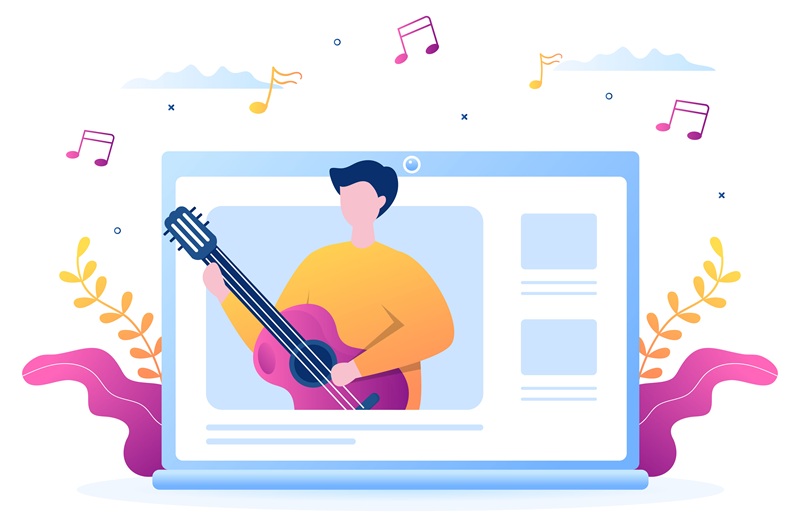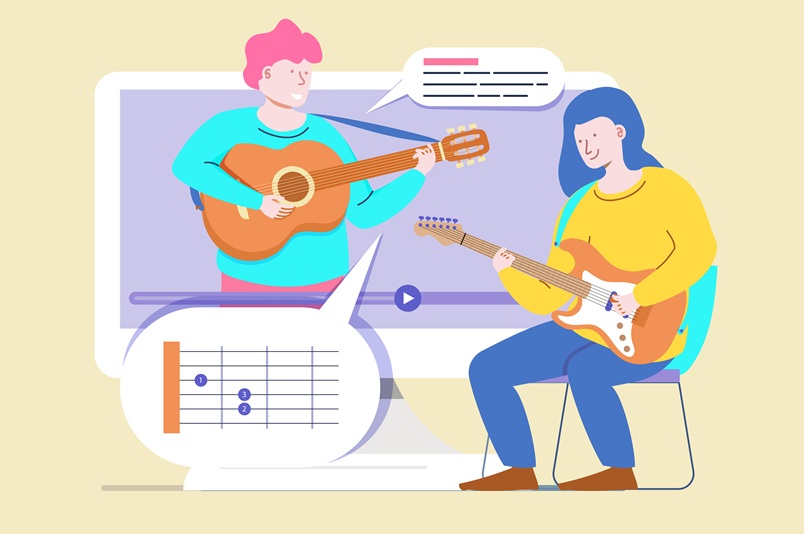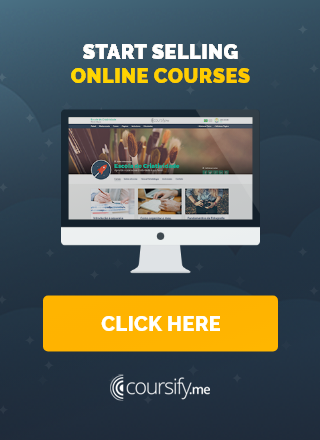Music lessons: Steps to Build a Music Course That Sells
If you want to create music lessons and sell a course in 2025, you have to be more than a great musician.
In this guide we will outline the basic steps you need to follow to create a course that makes sense and that has real chances to attract students, so read on.

How to create music lessons that sell
To create music lessons and put together a course, it’s necessary to start with the basics, like to really get your audience, know what they are struggling with.
There is also the tech side you cannot ignore. These days, if you are not showing up on TikTok or sliding into someone’s DMs with your promo, you are basically invisible.
Knowing the stuff that actually matters, from making music lessons that are not just another boring PowerPoint, to using your fanbase to hype your course up, makes a whole difference in your game.
On the next topics we will cover all this on a deeper level.
– How to use TikTok to sell online courses
Understand Your Ideal Student
Nobody will buy your music course if it does not actually speak to them. So, get to know your people.
Who is drooling over your lessons? Are they beginners fumbling their way through basic chords? Mid-level folks who get cold sweats when you mention music theory? Or are they bedroom producers trying to make their mixes not sound cheap?
Get super clear on their pain points. Someone desperate to stop writing lyrics probably needs bite-sized songwriting drills, not a lecture on mic placement. Meanwhile, the gearheads want slick recording hacks or mixing wizardry.
Do not just guess; go where they hang out, whether it is Reddit, Instagram, or some guitar nerd forum.
That is where you will see what keeps them up at night. Grab those real questions and use them to shape your music lessons.
Make your stuff sound like it was made just for them. If your students feel like you get them, they are way more likely to invest.
– How to know what my audience wants and attract leads
Craft a Clear and Focused Curriculum
Knowing your ideal student shapes how you structure your course.
A cluttered or overwhelming curriculum will send them running, so aim for simplicity and clarity.
One lesson = one goal. Do not dump three months’ worth of knowledge into a single video. That is just cruel.
A newbie guitar player does not care about jazz theory; they just wanna know how not to mangle simple songs. For beginners, you can think in a structure like that:
- Music Fundamentals: Notes and Pitches; Rhythms; Clefs; Time Signatures and Meter
- Instrument Technique: Posture; Hand Position; Basic Exercises
- Reading and Playing Music: Simple songs; Dynamics; Phrasing
In short, slice it up. Tiny pieces. Snack-sized. Anything longer than ten minutes and attention spans evaporate, and they are back doomscrolling on TikTok. Also, make it make sense.
You would not teach someone to shred before they even know what a chord is. If the course flows instead of being a brain-melting trivia dump, folks might stick around.
– Checklist to Create Online Course: Development Guide
Prioritize High-Quality Audio and Video Production
You could have the greatest curriculum in the world, but if your audio is crap or the video looks cheap, nobody will be sticking around for that.
Students actually want to hear what you are saying and will bounce fast if your sound sucks, especially when we are talking about music lessons.
Pay attention to lighting. If your face is half in the dark, or you have your messy laundry make a cameo behind you, no one will be listening to the lesson.
Get a decent mic and light from Amazon or other online platforms. You do not need Hollywood gear, just enough so people can see and hear you without squinting.
Editing does not have to be pro-level, either. A few jump cuts, some text when you need it, are enough, but do not let your transitions be amateur-level either.
Clean and simple does the trick. When your stuff looks pro, people feel like they paid for something legit.
So, in short you have to think about three things:
- Sound: get a mic and how we are talking about music lessons, think about the acoustic of the space in where you will be playing or singing.
- Light: a simple light ring can do the trick.
- Edit: there are several softwares to help you with that, including AI that really can make this part easier.
– 9 Tips for Creating Professional-Looking Videos
Teach Real-World Skills Students Can Apply Immediately
Flashy production will grab eyeballs for some time. But if you really want students to stick around, you have to give them stuff they can actually use.
For example, do not just toss theory at them; show them how to make it work in real life. Say you are running a course on songwriting. Show them how to format their tracks according to industry standards.
If you have got a bunch of future artists tuning in, do not leave them guessing about how to release music digitally by breaking down the steps for releasing tracks on the right platforms.
Show them how those platforms work with Spotify, Apple Music, all the big names. That is the stuff people remember.
Bottom line: When students walk away from a lesson and immediately pull off something new, that is when you know you have nailed it.
Makes them way more likely, actually, to finish your course and maybe even hype it up to their friends.
– Ways to Improve Online Education to Meet Modern Learners Needs
Leverage Your Existing Audience to Promote the Course
If you want people to take you seriously as a teacher, you gotta show them right off the bat that you have actually got something useful for them. Otherwise, they will just leave.
Once they see that value, they will start trusting you. Lean on your core crowd: the folks already on your email list, following you on socials, or those die-hard fans who never miss a gig. These are your MVPs.
Do not wait till the last minute to talk about your course. Start dropping little breadcrumbs early.
Maybe post a quick video of you working on the music lessons, or share a screenshot of your course outline, letting people peek behind the curtain.
Connect it back to your music, too. Like, “Remember that riff from my last track? Here’s how I break it down in the course.” This way, you create instant relevance.
Use your platforms like you mean it. Pin a promo post to the top of your feed. Fire up an Instagram countdown (people love a good countdown). Toss out a poll to see what they are actually itching to learn.
Folks want to feel like they are part of the process, not just wallets waiting to be emptied. Get them hyped and involved, and watch how much easier it is to sell.
– 6 Ways to Sell on Social Networks and Boost Your Online Business
Use Pre-Launch Strategies to Build Excitement
Once you have your audience tuned into what you are doing, it is time to spark some serious anticipation.
People need a reason to be excited about your course before it even drops. Here are some ideas:
- Create an exclusivity offer for first subscribers;
- Show sneak peeks of the music lessons, like a short clip from a module;
- Organize a live event with a free lesson to give your followers a taste of the value they can expect.
Also, throw in some early bird perks, limited-time discounts, and free goodies for pre-orders; make them feel like they are getting in on a secret before everyone else stumbles in.
Lastly, talk to your people. Get on a livestream, do a Q&A, mess around with a quick tutorial, whatever gets them hyped and reminds them you are a real human.
Stir up that buzz so when you finally launch, your audience is just waiting to hit the buy button.
– How to Pre-Launch Online Courses
Set the Right Price for Your Course
After you have hyped everyone up with your slick pre-launch moves, next comes the part that trips people up: putting a price tag on your course.
Go too cheap, and folks start thinking it must be of low quality. Shoot for the moon, and you scare some potential students.
Your price must be determined by who you are selling to. If you are pitching songwriting basics to newbies, they will probably be cool with dropping fifty bucks. But those seasoned audio wizards you are serving up advanced mixing secrets could cough up $200 without blinking. People pay for stuff that moves the needle for them.
Do not offer a single flat price. Throw in some tiers. The starter pack may be just the video lessons, while the top-shelf version includes live Q&As or a little one-on-one magic.
This approach gives everyone options, you make more cash, and nobody feels shortchanged.
Stay Consistent With Post-Launch Support
To wrap it all up, the real secret to a successful music course is what happens after the launch.
That is just the opening act, honestly. The real deal is what you do after everyone has signed up and the hype settles.
You cannot just cash out and ghost your students, expecting five-star reviews to rain down from the sky. Nope.
People wanna feel like you are actually in their corner, cheering them on while they fumble through scales or try to make sense of music theory.
Shoot them a quick email, maybe drop a surprise video, or hop on a live call now and then.
Set up a chill hangout spot on Discord, Facebook, whatever, so everyone can swap stories, freak out about progress, or just complain about finger cramps together.
Do this, and your students will stick around, probably finish the course, and then they will tell their friends how awesome you are.
It is the secret handshake to turning your course into a word-of-mouth legend.
Create Great Music Lessons And Sell It Online

Your music course is not just about ticking boxes or handing out sheet music.
It is about actually connecting with people, like sparking that little “aha!” moment when someone finally nails their first chord or drops their song online for the world to hear.
Every bit counts, even the messy stuff. Dive in, get your hands dirty, and you will be surprised at the magic that starts to unfold.
As soon as you have your music lessons ready, all you need is to host them on an eLearning platform like Coursify.me.
Complete Learning Management System, Coursify.me has all the features you need to create and sell courses on the internet.
– What is a Learning Management System (LMS)
To know more, visit our site, test the platform and understand why we are the best option for your online course.

